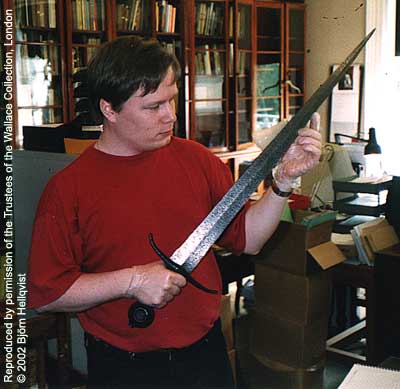Sword from the latter half of the 14th century
 This
sword (Wallace
Collection inv.# A.460) has several remarkable features, of which the most
important are the following: the grip is thought to be a 19th (?)
century replacement, the cross and pommel have a curious blue-black finish which
could be a combination of blueing and varnish. The sword appears to have been
cleaned in a rather severe way. The blade shows a number of shallow scratches on
one side, but according to David Edge, those could be the result of the sword
resting in river mud together with reeds (which have provided enough oxygen for
corrosion to take place). The blade has been ground down during its working
life, and was probably somewhat longer and wider when it was new. There are two
makers marks on the blade, in the form of the small copper crosses (6
mm/0.25) inlaid in the steel, one on each side, 165 (6.5) and 175 mm
(7) from the base of the blade, respectively. It is in good shape and handles
quite well, and is very tight and nice. It felt like a good thrusting weapon
when I handled it. The flattened-diamond cross-section of the blade tells about
it being intended for penetration of the tougher armour that was developed in
the 14th century.
This
sword (Wallace
Collection inv.# A.460) has several remarkable features, of which the most
important are the following: the grip is thought to be a 19th (?)
century replacement, the cross and pommel have a curious blue-black finish which
could be a combination of blueing and varnish. The sword appears to have been
cleaned in a rather severe way. The blade shows a number of shallow scratches on
one side, but according to David Edge, those could be the result of the sword
resting in river mud together with reeds (which have provided enough oxygen for
corrosion to take place). The blade has been ground down during its working
life, and was probably somewhat longer and wider when it was new. There are two
makers marks on the blade, in the form of the small copper crosses (6
mm/0.25) inlaid in the steel, one on each side, 165 (6.5) and 175 mm
(7) from the base of the blade, respectively. It is in good shape and handles
quite well, and is very tight and nice. It felt like a good thrusting weapon
when I handled it. The flattened-diamond cross-section of the blade tells about
it being intended for penetration of the tougher armour that was developed in
the 14th century.

Maker's mark
Close-up of the hilt
Oakeshott classification:
Blade type: XV (originally XVIII?)
Pommel type: K (recessed)
Cross-style: 7
Dimensions:
Length: 949 mm (37.4)
Blade length: 762 mm (30)
Blade width: 60 mm at the base (2.35)
Blade thickness at the base: 6,2 mm (0.24); 2,4 mm (0.1) 100 mm (4)
from the point
Pommel diametre: 57 mm (2.25), thickness 31 mm (1.2)
Width of cross: 218 mm (8.6)
Point of balance: 65 mm (2.5) from the cross
Location of primary node: c. 444 mm (17.5) from the cross
Weight: 1360 grams (3 lbs)
Bibliography:
James G. Mann & A.V.B. Norman: European Arms and
Armour in the Wallace Collection, p. 242 (vol. 1), p. 114 (vol. 2)
Ewart Oakeshott:
Records of the Medieval Sword, p. 133
 This
sword (Wallace
Collection inv.# A.460) has several remarkable features, of which the most
important are the following: the grip is thought to be a 19th (?)
century replacement, the cross and pommel have a curious blue-black finish which
could be a combination of blueing and varnish. The sword appears to have been
cleaned in a rather severe way. The blade shows a number of shallow scratches on
one side, but according to David Edge, those could be the result of the sword
resting in river mud together with reeds (which have provided enough oxygen for
corrosion to take place). The blade has been ground down during its working
life, and was probably somewhat longer and wider when it was new. There are two
makers marks on the blade, in the form of the small copper crosses (6
mm/0.25) inlaid in the steel, one on each side, 165 (6.5) and 175 mm
(7) from the base of the blade, respectively. It is in good shape and handles
quite well, and is very tight and nice. It felt like a good thrusting weapon
when I handled it. The flattened-diamond cross-section of the blade tells about
it being intended for penetration of the tougher armour that was developed in
the 14th century.
This
sword (Wallace
Collection inv.# A.460) has several remarkable features, of which the most
important are the following: the grip is thought to be a 19th (?)
century replacement, the cross and pommel have a curious blue-black finish which
could be a combination of blueing and varnish. The sword appears to have been
cleaned in a rather severe way. The blade shows a number of shallow scratches on
one side, but according to David Edge, those could be the result of the sword
resting in river mud together with reeds (which have provided enough oxygen for
corrosion to take place). The blade has been ground down during its working
life, and was probably somewhat longer and wider when it was new. There are two
makers marks on the blade, in the form of the small copper crosses (6
mm/0.25) inlaid in the steel, one on each side, 165 (6.5) and 175 mm
(7) from the base of the blade, respectively. It is in good shape and handles
quite well, and is very tight and nice. It felt like a good thrusting weapon
when I handled it. The flattened-diamond cross-section of the blade tells about
it being intended for penetration of the tougher armour that was developed in
the 14th century.